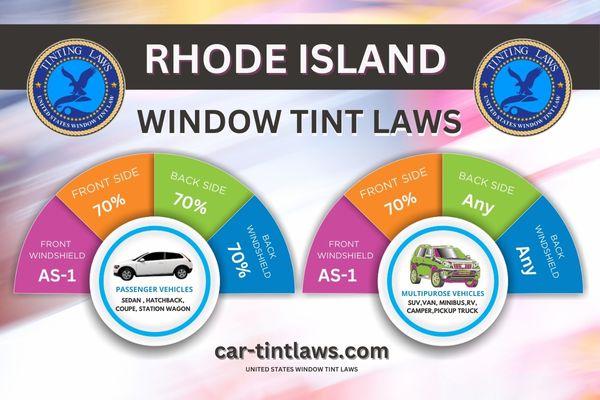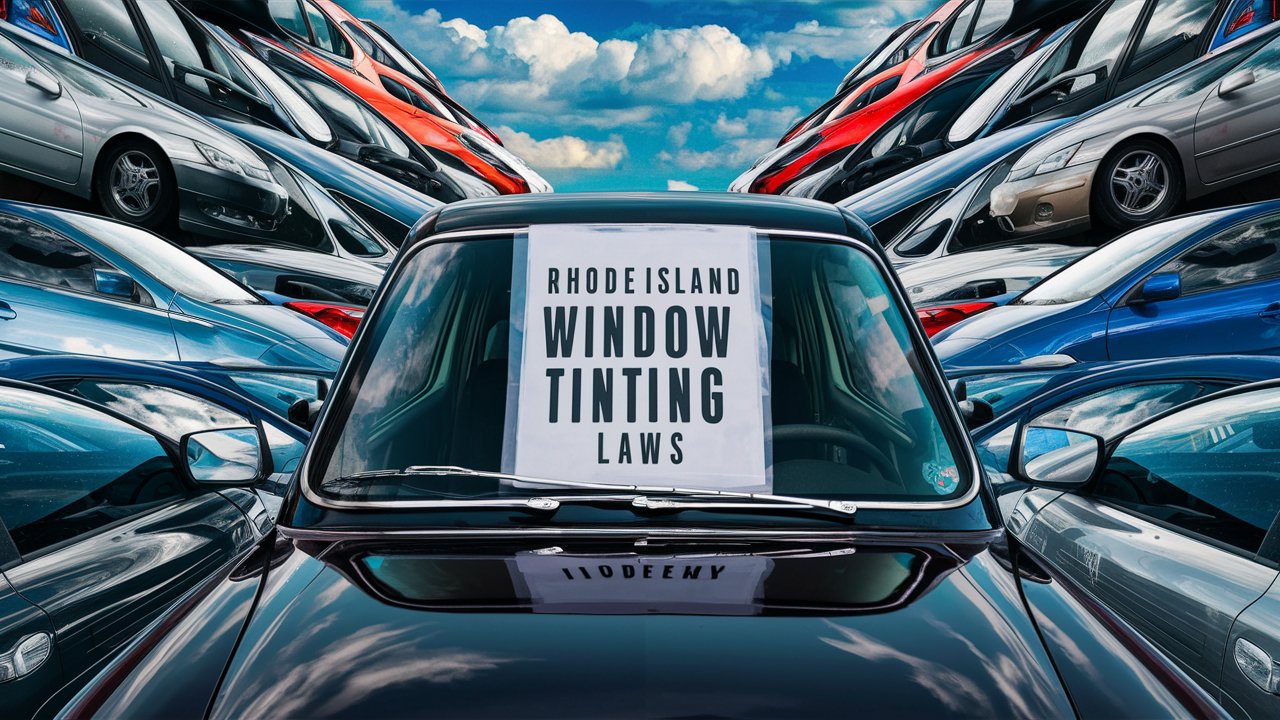You might not know that Rhode Island’s window tinting laws include not just darkness levels but also rules about tint reflection, which can differ for various types of vehicles.
These laws are more detailed than you might think, covering everything from sedans to SUVs and vans, with specific guidelines for each.
Understanding these distinctions is essential, especially if you want to avoid fines or having to remove non-compliant tint.
Plus, there’s an interesting aspect about medical exemptions that could affect people with certain health conditions.
Curious about how these rules might impact you or someone you know?
Window Tint Darkness in Rhode Island
When considering tint darkness for your vehicle in Rhode Island, it’s important to know that sedans must maintain a minimum of 70% visibility light transmittance.
For SUVs and vans, the rules are more lenient, allowing unrestricted tinting on rear windows as long as the vehicle has two outside mirrors.
Always make sure your tint complies with these regulations to avoid penalties.
Tint darkness for sedans:
- Windshield: Only non-reflective tint is permitted on the top 6 inches of the windshield.
- Front Side windows: The tint must allow more than 70% of light transmission.
- Back Side windows: The tint must allow more than 70% of light transmission.
- Rear Window: The tint must allow more than 70% of light transmission.
Tint darkness for SUV and Vans:
Windshield: Non-reflective tint is allowed on the top 6 inches of the windshield
Front Side windows: Must allow more than 70% of light in
Back Side windows: Any shade can be used
Rear window: Any shade can be used
Window Tint Reflection in Rhode Island
When it comes to window tint reflection in Rhode Island, you’ll find that the state doesn’t have specific regulations for sedans, SUVs, or vans.
The focus is on visible light transmission percentages, not how much light is reflected off the windows.
While reflectivity is a concern in some states, Rhode Island’s laws prioritize the amount of light that can pass through your tinted windows.
Tint reflection for sedans:
- Front Side windows: Reflectivity must not exceed 20%.
- Back Side windows: Reflectivity must not exceed 20%.
Tint reflection for SUV and vans:
- Front Side windows: Must not be more than 35% reflective.
- Back Side windows: Must not be more than 35% reflective.
- Rear Window: No restrictions on reflectivity if the vehicle has two outside mirrors.
Other Rhode Island window tint rules and regulations
- Side Mirrors: No restrictions.
- Restricted Colors: In Rhode Island all tint colors are permitted.
- Certificates: Manufacturers of film need to certify the film they sell in the state. Ask your dealer if they are using certified film.
- Stickers: The sticker/label of compliance to identify legal tinting is required between the film & glass on each tinted window.
- Medical Exceptions: Rhode Island permits medical exemptions for special tint. For more details about the specific terms of the exemption, consult RI state law.
- Penalties: Violating tint laws in Rhode Island can result in fines.

Medical Exemptions for Window Tint Rules in Rhode Island
Medical exemptions allow Rhode Island residents with specific health conditions to legally use window tinting that would otherwise be prohibited.
These medical exemptions cater to individuals facing skin-related medical issues or vision light sensitivity.
Rhode Island’s window tint rules specify that those with skin-related medical issues can apply for a tint with 35% light transparency.
For those dealing with vision light sensitivity, a 50% light transmittance level is approved.
To obtain these exemptions, you must apply based on medical necessity through the Rhode Island DMV, which processes applications monthly.
Once approved, you’ll receive DMV certificates that authorize the level of tint you’re permitted to use.
It’s essential to keep these certificates handy during vehicle inspections, as they serve as proof of your exemption.
Police enforcement in Rhode Island is aware of these medical exemptions.
Officers recognize these certificates and will take them into account when evaluating compliance with tint regulations.
However, if you’re found without proper documentation, you could face violations.
Ensuring you follow the correct procedures and have all necessary paperwork can help you avoid any potential issues with law enforcement.
Rhode Island Window Tint Ticket Cost
When you’re caught with illegal window tint in Rhode Island, you could face fines ranging from $85 to $150.
Exceeding the legal limit of 70% light transmittance can lead to a citation and various penalties.
These penalties aren’t just limited to fines; you might also be required to remove the non-compliant tint and potentially make court appearances.
The window tint ticket cost in Rhode Island doesn’t stop at the initial fine; it can also include court fees and other associated expenses.
Adhering to the state’s window tint laws is essential to avoid these costly repercussions.
Violations can quickly add up, especially if you need to appear in court multiple times to resolve the issue.
Making sure your window tint complies with the legal limit helps you avoid unnecessary fines and court fees.
In the long run, staying within the bounds of the law is not only safer but also more cost-effective.
Rhode Island Population and Size
Rhode Island, the smallest state by land area, has a population of approximately 1.1 million people, with a density of over 1,000 people per square mile.
Covering around 1,200 square miles, it’s one of the most densely populated states, second only to New Jersey.
This mix of urban and rural areas contributes to its growing and diverse communities.
Population Density Statistics
Despite its small size, Rhode Island boasts a remarkable population density of around 1,021 people per square mile, making it the second most densely populated state in the U.S.
This high population density is largely due to the state’s urban areas and its proximity to major cities like Boston.
As the smallest state by land area, covering approximately 1,214 square miles, Rhode Island’s densely populated nature contributes significantly to its vibrant economy and diverse cultural landscape.
With a total population estimated at around 1.06 million residents, Rhode Island’s compact size and close-knit communities foster a sense of belonging among its residents.
The state’s urban areas, including Providence and Newport, are hubs of activity that drive economic growth and cultural diversity.
The proximity to Boston further enhances the state’s appeal, providing additional opportunities for employment, education, and cultural exchange.
Moreover, the combination of Rhode Island’s small land area and high population density creates unique challenges and opportunities for urban planning and infrastructure development.
It underscores the importance of efficient use of space and resources to maintain the state’s vibrant economy and diverse cultural landscape while accommodating its growing population.
Geographic Area Coverage
Given Rhode Island‘s high population density, understanding its geographic area coverage becomes even more interesting.
Rhode Island, the smallest U.S. state by land area, covers about 1,214 square miles.
Despite its compact size, the state is home to over 1 million residents, making it the second most densely populated state.
Major cities like Providence, Warwick, and Cranston contribute significantly to this density.
When it comes to window tinting laws in Rhode Island, the state’s small size means that regulations are consistently enforced throughout.
The Rhode Island DMV stipulates specific laws regarding vehicle window tinting, especially for the front windshield and front side windows.
These laws are crafted to ensure that a certain level of light transmittance is maintained for safety reasons.
If you have medical issues that require special window tinting, the DMV allows for exceptions, provided you have the appropriate documentation.
However, enforcement is strict and steady, guaranteeing that all vehicles comply with the standard regulations.
Understanding these laws is essential for vehicle owners in Rhode Island, given the state’s high population density and small geographic footprint.
This knowledge helps guarantee that everyone adheres to the rules, making the roads safer for all residents.
Urban Vs. Rural Distribution
Understanding the stark contrast between urban centers like Providence and rural areas such as Foster reveals Rhode Island’s unique population distribution.
In Rhode Island, population density varies significantly between urban and rural areas.
Urban areas, including Providence, Warwick, and Cranston, are densely populated, contributing to Rhode Island’s overall high population density of over 1,000 people per square mile.
These urban centers drive the state’s dense population distribution, showcasing a typical urban-rural divide.
In contrast, rural areas like Foster and Exeter have much lower population densities, offering a different lifestyle and environment.
While the state’s small size means that urban and rural areas are relatively close to each other, the distribution of the population still reflects this clear urban-rural distinction.
Urban areas are hubs of activity, commerce, and services, making them attractive to many residents.
Meanwhile, rural areas provide more open spaces and a quieter setting, appealing to those seeking a different pace of life.
Understanding these differences in population density and distribution helps in grasping the varied living conditions across Rhode Island, informing decisions such as window tinting regulations that may differ based on these areas’ specific needs and characteristics.
References
Rhode Island General Laws Chapter 31-23.3: Non-Transparent Windshields and Windows
Frequently Asked Questions
What Is the Darkest Legal Tint in Rhode Island?
You’re interested in tint darkness and restrictions? The darkest legal tint in Rhode Island is 70% light transmittance.
With strict enforcement on legal limits, this guarantees window visibility and safety, balancing UV protection, heat reduction, and privacy concerns.
Can You Get Pulled Over for Tint in Ri?
Can you get pulled over for tint in RI? Absolutely. Police discretion plays a key role.
If your tint percentage is too dark, expect tint fines, tint tickets, and possible tint removal. Clear windows or valid medical exemption help.
What Is the Tint Law in Rhode Island 2024?
In 2024, Rhode Island law mandates a 70% tint percentage for vehicle windows. You’ll face fines for non-compliance.
Vehicle inspection guarantees tint visibility, UV protection, and heat reduction.
Medical exemptions exist, but regular tint maintenance is important.
How to Get a Tint Exemption in Rhode Island?
To get a tint exemption in Rhode Island, follow the tint exemption process: submit documentation required from a physician about medical conditions.
During vehicle inspections, verify your tint meets legal limits to avoid issues with police discretion and public safety.
Conclusion
Sailing through Rhode Island’s window tinting laws is much like piloting a ship through regulated waters.
You must guarantee your vessel, whether a sedan, SUV, or van, complies with light transmittance percentages for each window.
Medical exemptions are available for those with certain conditions, but they come with specific requirements.
Non-compliance can lead to fines and forced removal of tint. Stay within the legal limits to avoid penalties and guarantee smooth sailing on the road.
